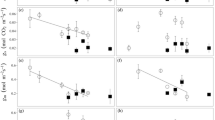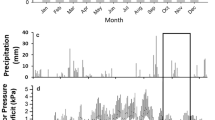Abstract
The natural ratio of stable carbon isotopes (δ13C) was compared to leaf structural and chemical characteristics in evergreen conifers in the north-central Rockies, United States. We sought a general model that would explain variation in δ13C across altitudinal gradients. Because variation in δ13C is attributed to the shifts between supply and demand for carbon dioxide within the leaf, we measured structural and chemical variables related to supply and demand. We measured stomatal density, which is related to CO2 supply to the chloroplasts, and leaf nitrogen content, which is related to CO2 demand. Leaf mass per area was measured as an intermediate between supply and demand. Models were tested on four evergreen conifers: Pseudotsuga menziesii, Abies lasiocarpa, Picea engelmannii, and Pinus contorta, which were sampled across 1800 m of altitude. We found significant variation among species in the rate of δ13C increase with altitude, ranging from 0.91‰ km–1 for A. lasiocarpa to 2.68‰ km–1 for Pinus contorta. Leaf structure and chemistry also varied with altitude: stomatal density decreased, leaf mass per area increased, but leaf nitrogen content (per unit area) was constant. The regressions on altitude were particularly robust in Pinus contorta. Variables were derived to describe the balance between supply and demand; these variables were stomata per gram of nitrogen and stomata per gram of leaf mass. Both derived variables should be positively related to internal CO2 supply and thus negatively related to δ13C. As expected, both derived variables were negatively correlated with δ13C. In fact, the regression on stomatal density per gram was the best fit in the study (r 2=0.72, P<0.0001); however, the relationships were species specific. The only general relationship observed was between δ13C and LMA: δ13C (‰)=–32.972+ 0.0173×LMA (r 2=0.45, P<0.0001). We conclude that species specificity of the isotopic shift indicates that evergreen conifers demonstrate varying degrees of functional plasticity across environmental gradients, while the observed convergence of δ13C with LMA suggests that internal resistance may be the key to understanding inter-specific isotopic variation across altitude.
Similar content being viewed by others
Author information
Authors and Affiliations
Additional information
Received: 1 June 1999 / Accepted: 2 November 1999
Rights and permissions
About this article
Cite this article
Hultine, K., Marshall, J. Altitude trends in conifer leaf morphology and stable carbon isotope composition. Oecologia 123, 32–40 (2000). https://doi.org/10.1007/s004420050986
Issue Date:
DOI: https://doi.org/10.1007/s004420050986




